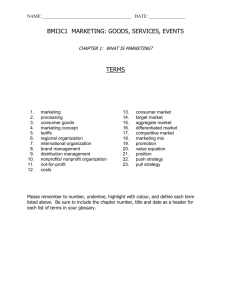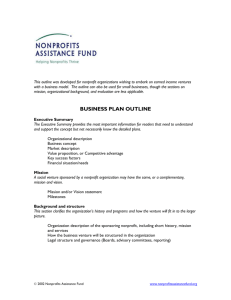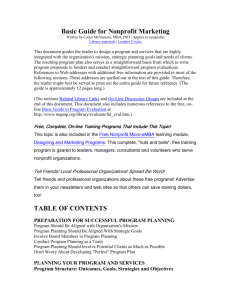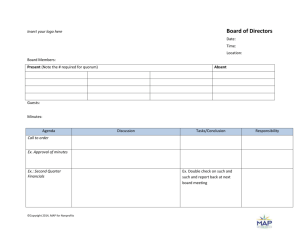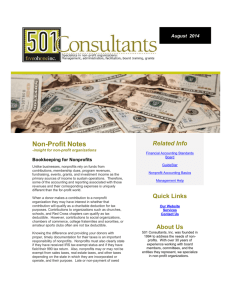city government and community-based non profits
advertisement
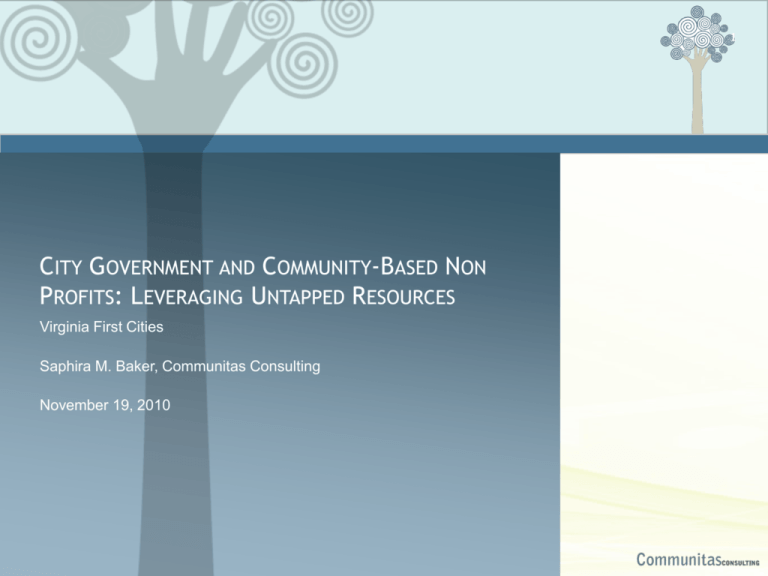
1 CITY GOVERNMENT AND COMMUNITY-BASED NON PROFITS: LEVERAGING UNTAPPED RESOURCES Virginia First Cities Saphira M. Baker, Communitas Consulting November 19, 2010 2 OVERVIEW Nonprofits as a Distinctive Feature of American Cities Why Pursue Strategic Partnerships Now? Nonprofits and City Government: Working Together for Community Improvement Benefits Risks Collaboration Strategies Unleashing Civic and Organizational Energy for Greater Results 3 DISTINCTIVE FEATURE OF AMERICAN CITIES “Americans of all ages, all conditions, and all dispositions constantly form associations….The Americans make associations…..to found seminaries, to build inns, to found hospitals, prisons and schools… …As soon as the inhabitants of the United States have taken up an opinion or a feeling which they wish to promote in the world, they look out for mutual assistance; as as soon as they have found one another out, they combine.” -- Alexis deToqueville, Democracy in America,1835 WHY NOW? CITY FISCAL CONDITIONS IN 2010, NLC 4 NONPROFIT PHILANTHROPY, 2010 Cygnus Donor Survey, 2010 44% of donors said the value of their gift had increased between 2008 and 2009; 29% gave less Donors predict “holding the line” in 2010; majority will support the same number of charities with same gift amount Only 8% of typical donors predicted they would give less in 2010, down from 17.5% in 2009. 43% shifting support to charities working locally 6 WHY ENGAGE NONPROFITS? In these economic times, can’t afford to leave resources on the table Larger regional nonprofits often have similar goals to City for community improvements Nonprofits increasingly investing in comprehensive community improvement initiatives Healthy, vital non-profit organizations have access to influential and creative civic energy and resources Private dollars can supplement City initiatives To reach greater numbers of residents with services 7 WHAT IS A STRATEGIC JOINT VENTURE? …And how does it differ from informal collaboration? Nonprofit and City Leaders Engage as Peers Make Business Case for Shared Effort Tap the Assets of Partners to Address Common Goal Communicate the Value and Results Together to Citizens Share Credit and Accountability 8 FROM COLLABORATION TO JOINT VENTURE Levels of Collaboration Collaboration “Occurs when people from different organizations produce something together through joint effort, resources and decision making and share ownership of the final product “ – Russ Linden Joint Venture A partnership or agreement between two or more companies to cooperate on a particular project that serves their mutual interest, and where they share risk and expertise. CURRENT “COLLABORATION” EFFORTS City Funder – Nonprofit Grantee Relationships History of City Government Viewing Nonprofits as Seekers of Funds or Sub-Contractors Keep Nonprofits at Arms Length for Objectivity City Reviews Agency Program Outcomes and Invests in Services Not Provided Internally City “Collaborates” by Supporting Agency to Address Pressing Community Need or Provide Resource INFORMAL FORMS OF “COLLABORATION” Sharing Ideas and One-Time Projects Invites to Meetings Meet to Discuss Conditions Share Information and Knowledge Co-sponsor Events Informal, One-Time or Program-Focused Initiatives 11 THREE LEVELS OF COLLABORATION Robert LaPiana 1. Project Specific Collaboration Informal, one-time, program focused 2. Joint Programming or Administrative Consolidation Formal, written agreement, long lasting 3. Merger or Acquisition Formal, involves legal changes to structure, permanent 12 WHERE CAN JOINT VENTURES WORK? Areas of Focus Community and Economic Development Civic Engagement of Residents Neighborhood Stability and Revitalization Retail and Business Investment Human Services School Readiness of Young Children After School Expansion Housing and Land Use Affordable and Accessible Housing Comprehensive Local Planning EXAMPLE: REGIONAL EARLY CHILDHOOD DEVELOPMENT INITIATIVE City of Richmond Early Childhood Development Initiative partnership with Smart Beginnings Since 2007, Public Awareness, Parenting Education (1600 parents), Quality Child Care, Home Visiting (460 families), Evaluation and Benchmarking Leveraged over $280,000 through Virginia Early Childhood Foundation, Infant and Toddler Mental Health Grant, and Smart Beginnings Initiated through Relationships, Technical Assistance and Strategic Partnership with United Way of Greater Richmond and Petersburg 13 WHAT ARE THE BENEFITS OF JOINT VENTURES WITH NONPROFITS? More Comprehensive Resources to Address Complex Community Problems Ability to Leverage More Resources Collectively Than Alone Better Use of Scarce Resources, Cost Savings Larger Capacity to Serve More Individuals Increased Coordination of Services Responds to Interests of Funders at Local, State and Federal Levels for Collaboration 14 WHAT NEW RESOURCES CAN CITY GOVERNMENTS ACCESS VIA NONPROFITS? Flexibility Link to Influential and Active Boards Ear to the Ground with Residents Fundraising Capacity Marketing and Communication Expertise Source of Information and Effective Practices Link to National Expertise and Resources Bridge Corporate, Civic, Faith-Based Sectors 15 WHAT ARE THE RISKS …AND STRATEGIES TO ADDRESS THEM? Risks City left “holding the bag” Takes credit away from City Perception of “special treatment” or loss of objectivity Lose credibility if nonprofit partner defaults Charisma and Influence of leader is greater than impact and sustainability Collaboration takes time and energy Challenge of blending of different cultures of public and nonprofits Strategies Develop joint venture agreement to share fiscal accountability and credit Issue request for partner with clear expectations and requirements No money changes hands Conduct “due diligence” interviews and review nonprofit leadership, track record, volunteer activities, references Build relationships before you need them, take small steps to test team Build sustaining relationships beyond leaders into agreement 16 WHAT MAKES A SUCCESSFUL NONPROFIT JOINT VENTURE PARTNER? Broad Community Building or Convening Role Track Record of Results and Sustained Impact Link to Diverse Civic and Nonprofit Groups and Residents Transparency and Accountability Trusted by the Community Credible Leadership of Board and Executive Perceived as “Neutral” and Fair 17 18 POTENTIAL NONPROFIT PARTNERS Community Foundations, United Ways Community Foundations Have a community building, technical assistance and problem solving role in addition to allocations. Taking on new leadership roles in community change, leverage donor and national expertise and engagement United Ways Focused on long-term community impact, play planning or convening roles, Strong corporate connections, marketing and community relations resources, linked to nonprofit and civic networks 19 POTENTIAL PARTNERS Regional Consortium or Issue Focused Organizations Non Profit Resources Centers Link to nonprofit members; focused on building the effectiveness of the sector; play convening role to bridge nonprofit, public and private sectors; foster collaboration Planning and Coordinating Entities Organizations established to leverage resources or improve practices in specific areas – housing, homelessness, human services; connected, credible Issue Focused Nonprofit Organization Source of expertise, capacity and state and national networks. Can leverage external funding. Understands and navigates local conditions, regulations and resources DESIGNING EFFECTIVE COLLABORATIVE JOINT VENTURES What Makes Them Successful? What are Future Opportunities for Cities? ATTRIBUTES OF EFFECTIVE NONPROFITPUBLIC JOINT VENTURES Trust and Openness Between the Sectors Shared Vision for Benefit of Community and Residents Sharing Credit for Improvements and Accountability for Results Recognize Nonprofits for Capacity and Impact and Credibility Local Government Demonstrates Receptivity and Inclusiveness….Reaches Out 21 22 HOW TO GET THERE: JOINT VENTURES Elements of Success 1. Develop Relationships Before You Need Them Cultivate joint projects, serve on committees, share data, Build trust and credibility 2. Tap Nonprofits for Ideas and Networks Take advantage of information, grass roots knowledge, and links to Board members and residents 3. Seize a Sense of Shared Opportunity Build on community momentum, grant opportunity, best practice, residents’ interest…..respond with a unified voice 23 ELEMENTS OF SUCCESS Continued 4. Have a Financial and Reputational Stake in the Initiative’s Success Combine and leverage funding sources, share accountability for results and progress 5. Define Roles, Responsibilities and Requirements Model it after emergency management agreements where roles are clear and practiced, and provide a compass in good times and bad 24 CURRENT FEDERAL OPPORTUNITIES Current Federal Grants for Broad-Scale Planning and Change: Sustainable Communities Regional Planning Grant Program – HUD Choice Neighborhoods - HUD Promise Neighborhoods – Department of Education Future Opportunities Federal Neighborhood Revitalization Working Group Includes HHS, DOJ, HUD Community Health Centers Byrne Criminal Justice Innovation Program 25 TAP RESOURCES IN YOUR COMMUNITY Strong Effective Nonprofits can Increase Impact with Efficient, Targeted Use of City Resources Engagement Can Expand Community Trust, Buy-in and Support Help Position the City for Collaborative Funding Opportunities to Sustain and Grow Initiatives Joint Ventures with an Effective Nonprofit Allows Cities to Reach More Residents QUESTIONS? Saphira M. Baker, Principal, Communitas Consulting 1839 Edgewood Lane Charlottesville, Virginia 22903 434/296-3317 www.communitasconsulting.com Baker@communitasconsulting.com
